Saturday, February 2, 2008 | posted by neil gitkind | Comments Off on Not About Seattle
This is an exciting moment in American Political History. We have recently entered the final year of the hated GW Bush’s reign, and we are in the midst of the “primary” fight to succeed him. Today, the Saturday before the ’08 Super Tuesday” primary – which somehow drifted from March to February – We got Billary (Hillary + loudmouth Bill) and Obama in a dead heat, two weeks after he blew her out in the South Carolina primary. On the Republican side we got the maverick, sorta centrist John McCain on an apparent glidepath to the nomination (Romney is nipping at his heels but is behind in the polls, and just can’t seem break out of robo-candidate form.)
This Republican situation recently produced an interesting vignette: the three “leading” “moderate” Republicans in the Country, on a podium, basking in the possibility of a Re-imagining of the Right. There they were: Guiliani and McCain, with Schwarzenegger bragging about the ability to “cross the isle”. Are these guys going to get creamed by a betrayed and outraged Republican “values” voter bloc? If Romney sinks as expected, what will McCain owe the “Religious Right?” The movement seems to have imploded of it’s own choice. Then again, perhaps I am jumping the gun in eulogizing the Intolerant Right.
The Dems are seemingly strong, Hillary and Obama having their various strengths and weaknesses, all adding to roughly the same level of promise for the General Election. (In fact, one must assume that it is this very strength that has led Republican primary voters to go to the middle.) On the other hand things could play out very differently for the two candidates. Maxine Waters, the firebrand (Black) California Congresswomen just endorsed Hillary. She apparently said that “we don’t need more hope, we need help” (or words to that effect). This epitomizes the concerns about Obama. Can he really steer the ship of State? …through the shoals of Congressional hardball? Could he Deliver the Goods? It’s just very interesting to wonder whether these Democratic primary voters (with whom we in WA are not) will choose to bolster Obama, or anoint Hillary. Or perhaps they are divided – like me.
Saturday, February 2, 2008 | posted by dan bertolet | Comments Off on Death of a Street Wall
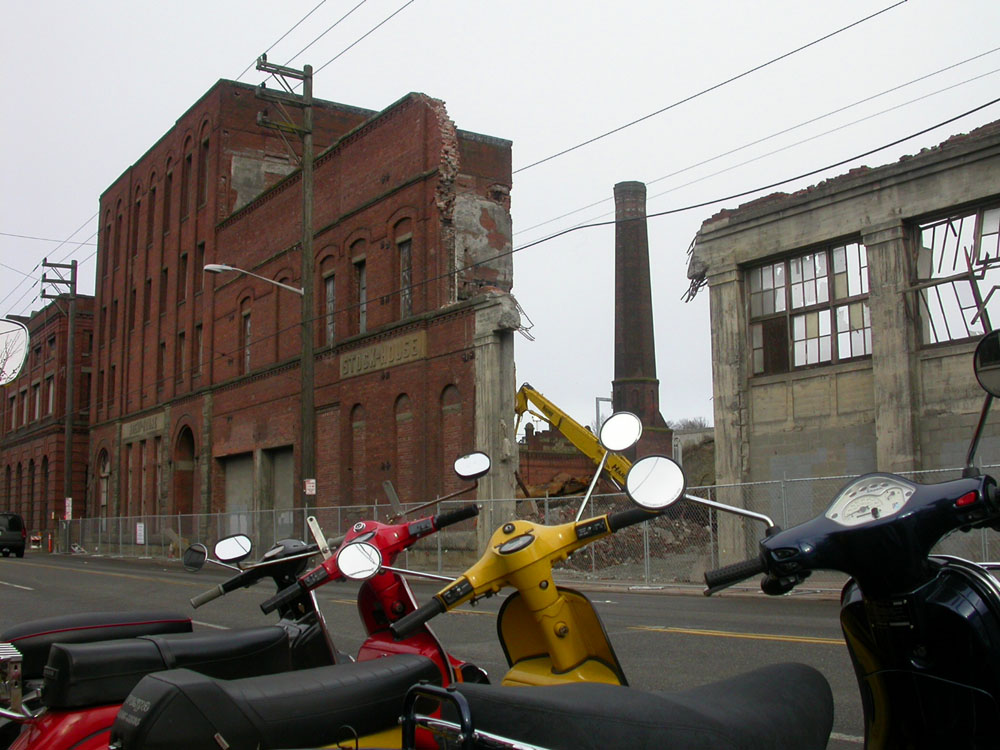
[ Photo: Dan Bertolet ]
This was the mother of all street walls, on Airport Way in Georgetown: about 50 feet straight up, and only 5 or 6 feet back from the curb. The sense of enclosure you’d feel along this street was like nothing else in Seattle.
Though some speculate otherwise, the demolition of the Rainier Cold Storage “Stockhouse” building is not just another case of gentrification run amok. As reported here, the floor of the building had frozen the ground underneath it, and after the cooler was shut down in 2002, severe settling rendered the building structurally unsound.
As for gentrification in Georgetown, there are some fundamentals working against it. The neighborhood is buried in freeways, offramps, railroads, airports, industrial warehouses, paint factories and the like. Another Wallingford it can never be. It’s hard to imagine it going to much more upscale than All City Coffee. Good thing that.
Thursday, January 31, 2008 | posted by dan bertolet | Comments Off on Double Vision
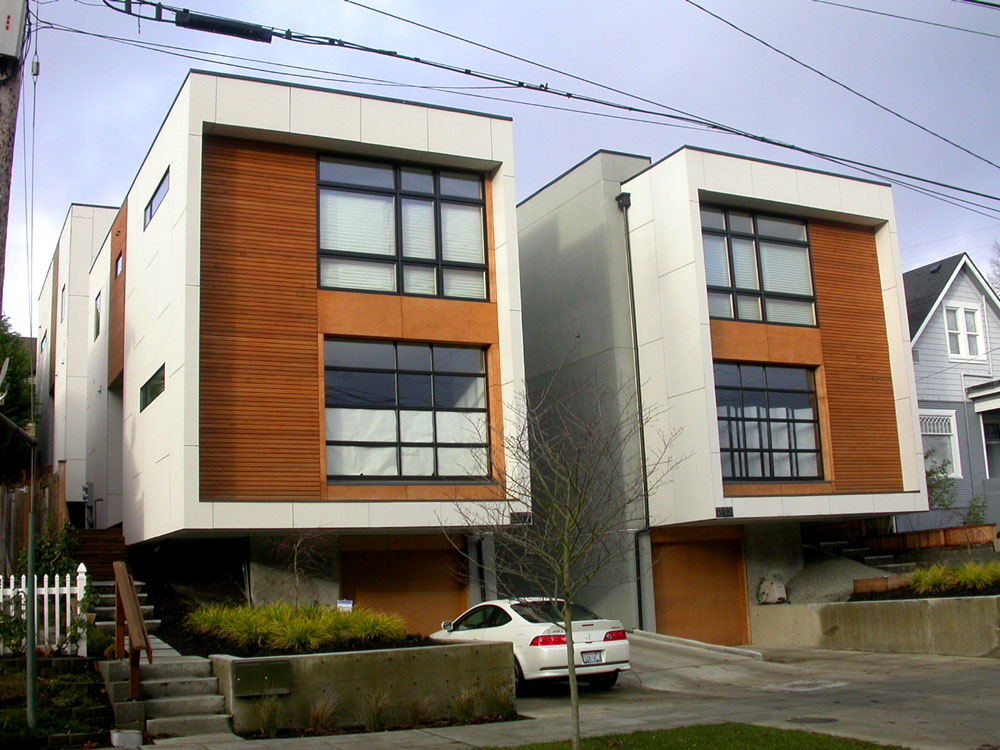
[ Photo: Dan Bertolet ]

[ Photo: Dan Bertolet ]
Do I detect a pattern here? Both projects were designed and built by Pb Elemental. Now don’t get me wrong — for the most part I love this firm’s work. But I couldn’t help noticing how many of their projects have this mirrored dual symmetry (e.g. the live-work project noted here).
Pb Elemental is proving that it is possible to produce townhouses that don’t suck. However, I have to point out that both of the projects pictured above are a bit weak when it comes to engaging the street. Hmm, where are the front doors? Frontages like this are not conducive to people interacting with their neighbors. Imagine the project in the lower photo with four cars parked up against it — a pretty sorry street presence.
As with most townhouses, even the thoughtful designs shown above are debased by accommodating cars.
Wednesday, January 30, 2008 | posted by dan bertolet | Comments Off on 23rd and Union
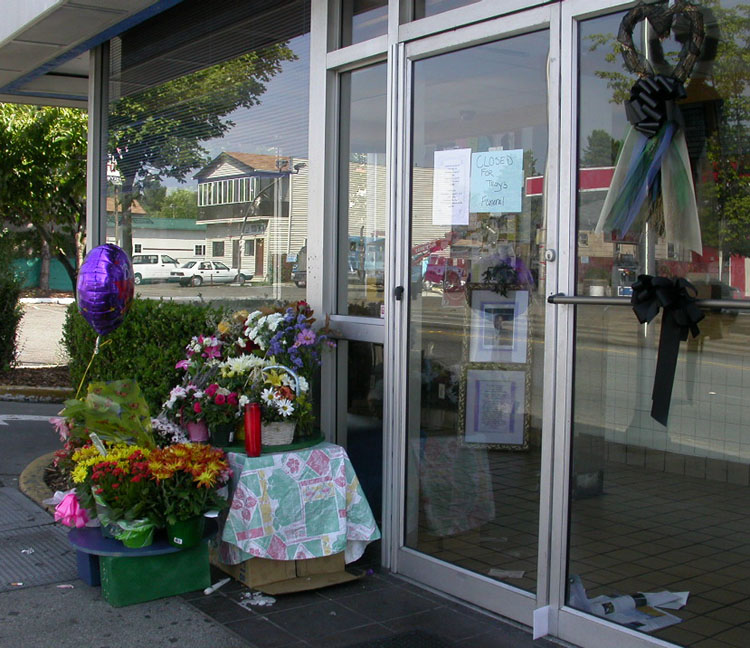
[ Photo: Dan Bertolet ]
This is the front door of Philadelphia Cheese Steak at 23rd and Union, in 2003. The sign on the door says “Closed for Troy’s funeral,” referring to the owner who was shot dead in his car a few blocks away.
Today the subsequent owner was shot and killed, and a second man critically wounded.
Coincidental, random acts of violence, perhaps. But one thing for sure is that 23rd and Union is one of the most miserable intersections in the City.
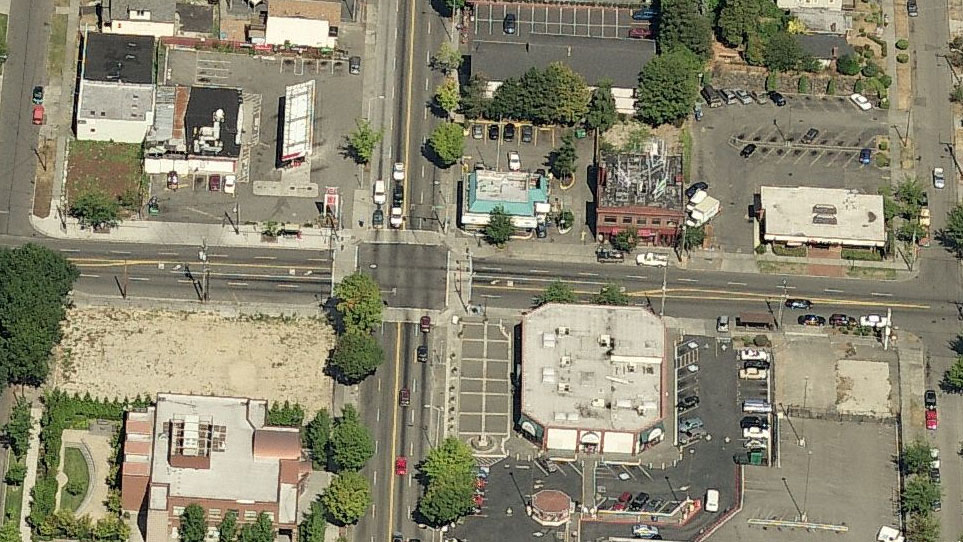
Given all the vacant lots and big empty parking lots, along with relatively few viable businesses with street presence, it’s not too surprising that street crime flourishes. I find it remarkable how underutilized this intersection is, especially considering how close it is to downtown, Capitol Hill and Madrona.
The vacant lot on the SW corner has had a chain link fence around it for seven years. A six-story mixed-use building with apartments is being planned for this site (more on this to come in another post). I’m optimistic that this will be the beginning of a new life for 23rd and Union.
Wednesday, January 30, 2008 | posted by WB | Comments Off on Blogs and Information Contained Therein
Tuesday, January 29, 2008 | posted by dan bertolet | Comments Off on Townhouses Not Feeling The Love
No need to post a photo. If you live in Seattle, chances are you can throw a rock and hit one from your front door.
Over in West Seattle, architect and design review board member David Foster has been grumbling about micro-permitting, received this response from Richard Conlin, and even SLOG piled on. No doubt micro-permitting should be stopped, but there’s more to the problem, as I see plenty of shitty townhouses on single lots.
And over in the Central District, folks in the Squire Park Neighborhood have been raising concerns over proposed changes to multifamily zoning, while the Miller Park Blog and the Central District News hone in on the key issue: parking.
The best townhouses I’ve seen in my neighborhood are still highly compromised from an urban design standpoint by the requirement to accommodate cars. Even Seattle’s first LEED certified townhouses have an awkward ass-backward orientation to fit in two parking stalls.
So then, why is the City regulating parking at all? The market will provide parking if there is a demand. Currently, the City is in effect mandating bad urban design. And the same applies to larger buildings with their aircraft carrier-sized parking decks and gaping garage entrances.
We cannot have it both ways. Stuffing a building with parking stalls almost always leads to bad urban design. Here’s what Lewis Mumford had to say about it way back in 1961:
“The right to access every building in the city by private motorcar, in an age when everyone owns such a vehicle, is actually the right to destroy the city.”
Sunday, January 27, 2008 | posted by dan bertolet | Comments Off on Does Live-Work Work?
UPDATE: See comment #1 for a clarification on the building shown below from the developer. In short, it is not live-work, but “live above work,” consisting of five separate mixed-use buildings.

[ Photo: Dan Bertolet ]
This is a recently constructed live-work unit development at 25th and E. Union in the Central District. There are five units, with commercial space ranging from about 500 to 900 sf, and residential space from about 1400 to 1500 sf.

[ Photo: Dan Bertolet ]
The City of Seattle approved a live-work unit ordinance in 2003. Live-work units combine residential and commercial space in a single unit, and residents must possess a business license. A key provision in the code is that no parking is required for the residential portion of the units, which provides design flexibility and encourages small-scale buildings that are not dominated by surface parking or garages.
It’s easy to like the idea of live-work units. They encourage small businesses and help strengthen community at the neighborhood level. They bring interest and activity to the street. And they help reduce commuting.
But I can’t help being a tad skeptical: Do they work as advertised in the real world? What fraction of the live-work units out there have healthy, operating businesses, and what fraction are essentially functioning as apartments? Is there demand for these units in Seattle, or is there already a glut? Help me out here — anyone?
The project shown above is relatively isolated from other commercial uses and gets very little passing foot traffic. And so these spaces are not likely to be successful for many types of businesses, at least until there is more commercial development around 23rd and Union.
Coincidentally, there are two more live-work developments proposed within a few blocks of the E. Union St. project described above. The first is at 26th and East Cherry St (careful, big pdf) , rendering shown below:

The second is on East Union between 20th and 21st, designed by Pb Elemental, rendering below:
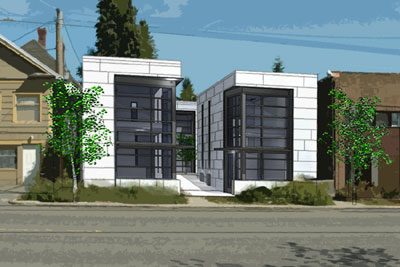
These two projects are also located in areas that will not provide much commercial synergy. All three live-work developments will be will be trailblazers, and here’s to hoping the neighborhood can absorb and support them.
Thursday, January 24, 2008 | posted by dan bertolet | Comments Off on LEED Silver Townhouses

[ Photo: Dan Bertolet ]
Seattle’s first LEED certified townhouses, designed by OPA, built by Cascade Built. Located in the Central Area, at 712 26th S (one block west of MLK Way, two blocks south of Jackson), currently priced at $450k.
They claim these townhouses will be 30-50% more energy efficient than a typical home. That’s pretty impressive given that they haven’t done anything that radical. The most unusual feature: heat recovery ventilation.
And my favorite detail: they’ve set up wiring and plumbing for future installation of photovoltaics and solar hot water. I don’t believe there are any LEED points to be had for this sort of pre-setup, which suggests that the builder did it simply because it’s the right thing to do. Bravo.
The one unfortunate aspect of this project, which you won’t see in the real estate photos, is the siting. As shown below, the building is on the back half of a standard single-family lot, jammed in behind an existing house. It is completely paved between the two buildings. Nor is there an alley for access to the back side (shown in the upper photo). Too bad that this innovative project is on such a clunker of a site.

[ Photo: Dan Bertolet ]
Monday, January 21, 2008 | posted by dan bertolet | Comments Off on Worst Open Space Design EVER

This is the open space on the roof of the the City’s Medgar Evers swimming pool, on 23rd Ave between Jefferson and Cherry, in the Central District. I have yet to see a more pathetic open space, anywhere.
It was designed by firm of the late Seattle architect John M. Morse, who had previously worked with Fred Bassetti. In 1970 the Seattle AIA recognized the Medgar Evers pool with an “Exhibition Award.” Embarrassing.
For most of its life, this open space has served as a great place to hang out and drink from bottles in paper bags, and for smashing those bottles on concrete. In recent years, ever-resourceful skateboarders and bikers have discovered it, pulling off insanely impossible maneuvers in the most unlikely places.
I think it would be a perfect place for a City of Seattle green roof demonstration.
I’ll let the pictures speak for themselves, starting with this birdseye aerial, looking east. Yup, that thing that looks like some kind of WWII-era bunker is the space in question.

Here’s how it looked when it opened, looking SE from 23rd Ave:
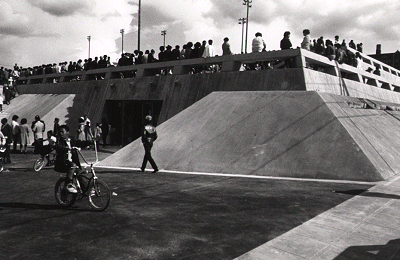
And here’s how it looks now, on a sunny winter day:









Saturday, January 19, 2008 | posted by dan bertolet | Comments Off on Cars and Posthumanism: Chapter 1
(Note to self: If you ever want to murder someone, use a car to do it.)
The driver who killed a pedestrian in a crosswalk in November 2006 in West Seattle was convicted of assault, with a maximum sentence of 1 year in prison and a $5000 fine. An appeal is expected, because the city law under which he was charged allows a more severe sentence than the norm — the norm being essentially a slap on the wrist.
Tragedies like this — and they happen all the time — are SO revealing about how warped our attitudes are when it comes to cars. If there was a disease, or a food, or a behavior, or a machine, or any other anything that caused anywhere near the death and destruction that is consistently caused by cars, there would be a national uproar. We are a society that is hyper-aware of safety — except with cars. Even though getting into a car is by far the most dangerous thing that the average person does in their daily life.
Yes, we all get distracted from time to time when driving. It easily could have been me or you who killed that pedestrian. But that excuse is precisely the problem. We’re not taking responsibility for the deadly power we are wielding when we drive cars. We need our attitudes adjusted with better training, stricter laws, and better enforcement. We need to get over our bizarre cultural imbalance that some have called “carhead.”
The photo below is but one example of the lack of seriousness with which we take pedestrian safety. There are crosswalks with the paint eroded away like this all over the city. Yet we know that well marked crosswalks help drivers become more aware of pedestrians. Is paint really that expensive? Not as cheap as life, apparently.

This post is part of a series; see also Chapter 37.
Thursday, January 17, 2008 | posted by dan bertolet | Comments Off on Same As It Ever Was, Ballard-Style
Reality today, in Ballard, on NW 46th St, between 14th and 15th Ave NW:
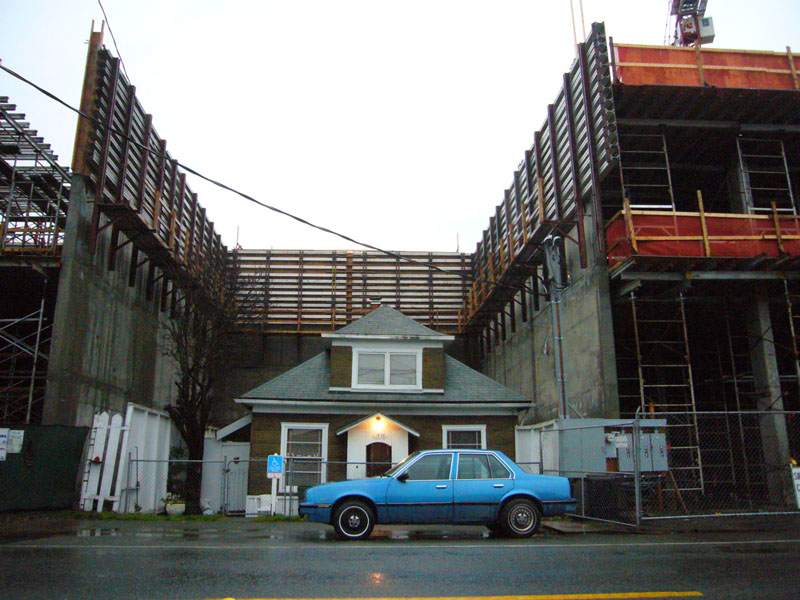
[ Photo: kurt schlosser; flickr.com ]
And below, an illustration from the children’s book The Little House, by Virginia Lee Burton, published in 1942:

Read all about the Ballard holdout here. The project is filed under Seattle MUP #2500969. I couldn’t dig up any details on the developer or architect so if anyone out there has info, bring it on.
Monday, January 14, 2008 | posted by dan bertolet | Comments Off on Green Vegas
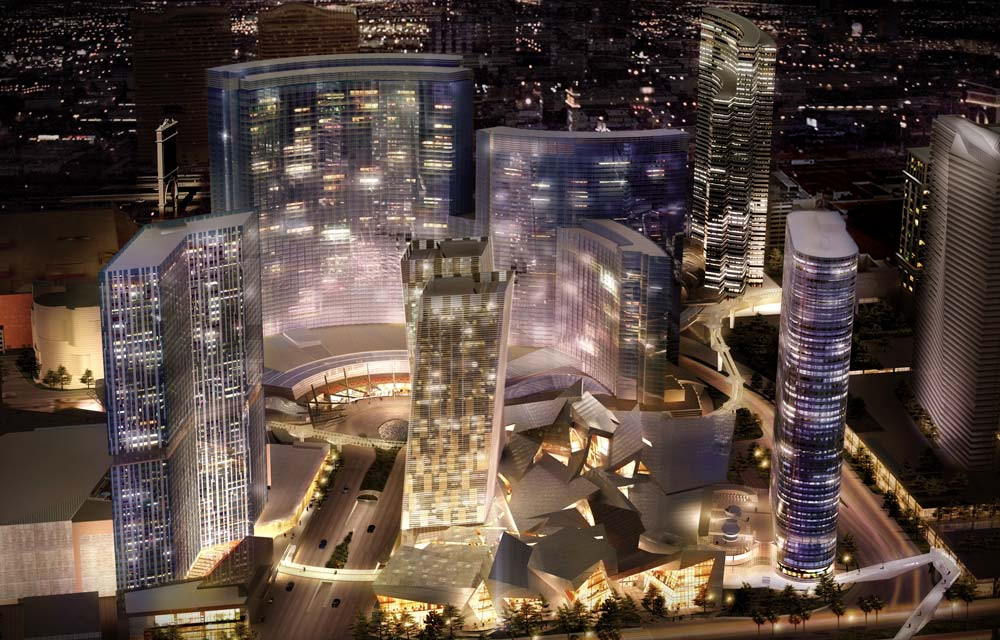
This is MGM Mirage’s $7.5 billion CityCenter, currently under construction on the Las Vegas strip, touted as the most expensive privately funded project in U.S. history. But mark this: the glowing, other-worldly mega-gambling mecca you see above is actually targeting LEED certification, in exchange for rebates on state sales and property taxes.
This thing is such a walking self-contradiction on so many levels it makes me dizzy. On the one hand, sure, it’s great that they are going for LEED, and that the buildings will consume less resources and be healthier for people, and that it is establishing green building expertise and supply lines in the region.
On the other hand, could anyone not agree that this complex is a massive net loss for humanity and the planet? It’s primary purpose is to take money from people through gambling. And to that end, it’s going to burn up absurd amounts of energy, spew untold tons of CO2 into the atmosphere, and suck down a bazillion gallons of water in a location that has none, not to mention all the energy and C02 emissions associated with people traveling to get there. (OK, I’m a killjoy. I’ve also been known to whine about green luxury condos.)
I totally respect the U.S. Green Building Council, but now that green building is relatively established, perhaps it is time to consider whether there are certain building uses that should simply not be eligible for LEED certification. If casinos were ineligible for LEED certification, the CityCenter project could not have qualified for the tax breaks, and it probably wouldn’t have been built. Would that have been such a loss?
Monday, January 14, 2008 | posted by WB | Comments Off on We’ll Never Figure it Out, but we still Bitch about it
Sunday, January 13, 2008 | posted by neil gitkind | Comments Off on Shmegulation

How does more taxes, pro-abortion, pro-partial birth abortion, pro-gay rights, pro-regulation, how does that play…(ANDREW NAPOLITANO, FOX News senior judicial analyst: The Big Story with John Gibson, 7/7/04)
So I am thinking about that bland phrase “pro-regulation”, and how it’s actually code for “tree hugging mother f*k*r”. And how pointless, really, it is to point out that when the phrase is taken at face value, it is powerfully meaningless. And I am considering what a complete waste of time it is to point out that if one were to claim being pro-regulation, or anti-regulation for that matter, than one might as well be saying, if you live in Chicago, for example, that you are pro-Winter or pro-Summer. You might seriously believe that the warm weather is preferable, or that you, to the contrary, love Winter’s warm hearth, and don’t forget the magic of the Holidays, and that Summer humidity is just unbearable, but wait! how about those July Fourth barbecues, and bike rides along the Lake! Of course, none of this prognosticating matters because Winter will come and then Summer will come, and then Winter will come again and so on.
Regulation is simply the weather. We don’t argue about whether we need it IN GENERAL. The uncomfortable fact that Capitalism would be a flat failure without regulation is one of the most ridiculously OPEN dirty little secrets of American Culture! I can hardly stand it. It’s even true that Adam Smith HIMSELF argued that government must reign in the excesses of private capital (See Schlesinger’s The Age of Jackson; he has a great chapter on this.) This is almost religiously forgotten.
But, like I said, what a waste of breath to even BROACH the subject…
Sunday, January 13, 2008 | posted by dan bertolet | Comments Off on Also Blame Where The Buildings Are
The “blame the buildings” series (here, here, and here) was meant to emphasize how energy use in buildings accounts for a bigger chunk of total CO2 emissions than is generally recognized. Of course it also matters where buildings are located relative to other buildings and services, since location has a big impact on transportation-related CO2 emissions.
The Urban Land Institute has just published a report called “Growing Cooler,” that attempts to quantify the effects of land use patterns on transportation-based CO2 emissions. The authors conducted an extensive literature review, which revealed that, as a rule of thumb, compact development reduces driving by 30 percent. And the bottom line: by 2050, if 60 to 90% of new development is compact as opposed to status-quo sprawl, transportation-related CO2 emissions would be reduced from current trends by seven to ten percent.
Seven percent may not sound like much, especially when you factor in that transportation accounts for about 1/3 of total CO2 emissions, so that we’re actually only talking about a two percent total reduction. But, as the authors note, that seven percent reduction must be appreciated in perspective. Assuming business as usual, the U.S. Energy Information Administration currently forecasts that between 2005 and 2030 vehicle miles traveled by cars and light trucks will increase by 59%, with a corresponding increase in CO2 emissions of 41%, as shown in the graph below.
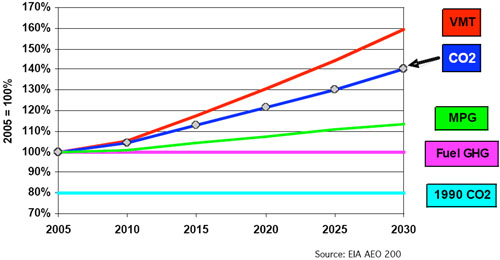
In the context of of motor vehicle fuel efficiency, the authors estimate that if 60 percent of new development is compact, by 2030 the transportation-related CO2 emissions reductions would be equivalent to raising the U.S. fleetwide efficiency to 32 mpg by 2020. Thus, every resident of a compact neighborhood would provide roughly the same environmental benefit as driving a hybrid does today.
The seven percent also does not include CO2 emissions reductions that would result from the higher energy-efficiency of buildings in compact developments (estimated at 20 percent), or from the forests that would be preserved with compact development.
Overall, what all this is saying to me is that there will be no magic bullet solutions. CO2 emissions are so deeply embedded in our way of life that we must go after every potential means for reductions, as aggressively as possible. The authors of the ULI report were probably hoping to be perceived as realistic by choosing 60% compact development as a goal. We need to be shooting for 100%.
Thursday, January 10, 2008 | posted by neil gitkind | Comments Off on Hell to the People
I really feel like an outsider. Maybe it’s just red state/blue state sort of thing. I feel foolish because I insist on believing that it’s OK that our government should raise taxes in order fix problems. Especially problems like bridges threatening to break apart, or even Seattle’s Ferries rusting towards decrepitude.
So when Chris Gregoire, our “straight talking” Democrat Governor strikes from her vocabulary, the phrase “raising taxes” – for just those types of things – even going so far to say that “the people have spoken loud and clear and they don’t want new taxes”, thereby “respecting the will of the people” I find this to be profoundly disheartening. This is of course the outcome of the failure of Proposition 1, our huge roads and transit Ballot proposition this past November.
What I actually heard the Governor say on the radio was that there was $2b available to pay for the 520 Bridge, which MUST be replaced at a cost of $4b, and that because “the tax payers have spoken” there will be no taxes, so it will need to be done with tolls. WTF?
So here’s what I am wondering: Am I really so unimaginative as to believe that there cannot be some “exciting and innovative” ways to raise revenue that would 1)fix our decaying infrastucture, 2)clean up our messes, 3)regulate our economy, 4)fight our oil-wars and.. (oh well it’s a long list.)? Because if I really am that unimaginative, and if it is actually true that the masses are in fact more visionary when it comes to these things, then I just want to find a way to deal with it. A way to stop my griping and just get on with my life.
If you have any ideas – please let me know.
Tuesday, January 8, 2008 | posted by dan bertolet | Comments Off on 12th and Pike is Getting All Mod On Us
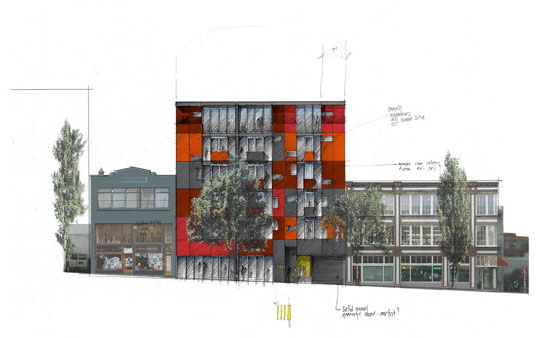
That big hole in the ground that’s been there forever at 1111 East Pike on Capitol Hill is finally getting filled with building. Designed by Olson Sundberg Kundig Allen; five stories of condos over ground-level retail over two underground parking levels, currently under construction. Looks to be a good mate to Agnes Lofts up at the corner (shown in outline at the left edge of the rendering). That is to say, not typical Seattle-style un-inspiration.
The lot is roughly 60 feet wide, and while that’s not quite as small as 1310 East Union, it’s easily within the “small is beautiful” regime, e.g. note the unobtrusive garage door. Note also how it will be flanked by two older existing buildings, which will give the block a rich diversity in both form and age. Infill done right.
Monday, January 7, 2008 | posted by dan bertolet | Comments Off on Mainstream = Time Magazine = LEED-ND
The LEED for Neighborhood Development pilot program was only launched last summer and already it has been discussed in Time Magazine. A quote: “What is causing global warming is the lifestyle of the American middle class,” says Duany. “It’s terrible for nature and for humans.” Great to see this in one of the most mainstream publications in the U.S., but then again, does anyone actually read Time anymore?
Sunday, January 6, 2008 | posted by dan bertolet | Comments Off on Genius Compromise on Ballard Denny’s
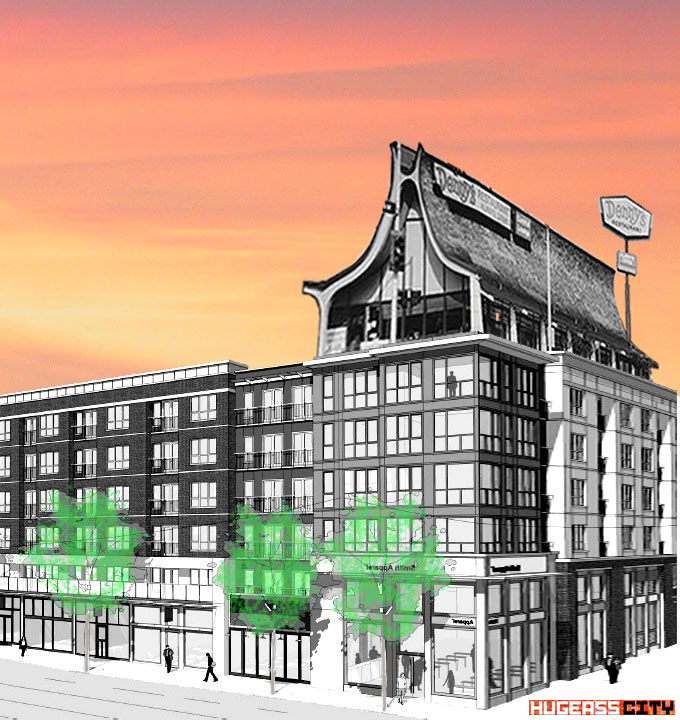
After extended weekend meetings, the Seattle Design Commission and the Landmark Preservation Board have unveiled a draft compromise agreement on a proposed mixed-used development at 15th Ave NW and NW Market St that would require the demolition of a building recently nominated for landmark status. The artist’s rendering above illustrates the bold vision of the proposed solution, which is expected to please all stakeholders.
The creative spark behind the proposal was said to have originated with Design Commissioner Henry Miller Lite, inspired by a post he had read on local urbanism blog hugeasscity. The post in question noted how a 16-foot neon Wonder Bread sign salvaged from the factory that was demolished for redevelopment will be placed on top of the new condo building.
Thursday, January 3, 2008 | posted by dan bertolet | Comments Off on 15th and Market: Fuggettaboudit

Grok the intersection above. Classic suburbia, no? Six lanes meets seven lanes, a gas station next door to a Burger King with a drive-through, a chain drug store set well back from the street for convenient access by car, a grocery store lost somewhere behind a sea of parking.
This is the intersection of 15th Ave. and Market Street in Ballard. As previously reported, the Denny’s building on the NW corner has been nominated for Seattle Landmark status, likely scuttling plans for an 8-story mixed-use residential building.
Regardless of how you feel about the uniqueness of the Denny’s building, and regardless of how you feel about the need for densification, one thing is clear: From the perspective of the pedestrian, this intersection is a lost cause. And it will be for a long time to come. The Walgreen’s and Safeway are relatively new buildings. The gas station and the Burger King, backed by all their corporate might, are pretty much untouchable.
As with toddlers, we might do well to “pick our battles.” So whatever, keep the Denny’s. 15th and Market is perfect for it. Two 8-story mixed-use residential buildings are currently under construction on either side of Market Street, about half a block west of 15th. The urban village starts there.


































